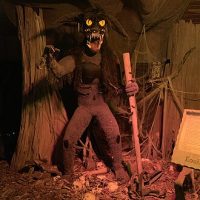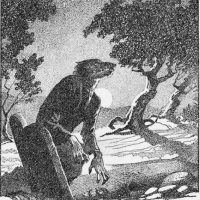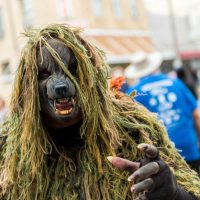Rougarou : The Cajun Werewolf
Listen
At a glance
| Description | |
|---|---|
| Origin | Cajun Mythology |
| Classification | Hybrids |
| Family Members | N/A |
| Region | United States of America |
| Associated With | Shapeshifting, Superspeed, Strength |
Rougarou
Introduction
The Rougarou is one of the most enduring figures in Cajun folklore, a terrifying yet captivating creature that has haunted the imagination of southern Louisiana for centuries. Often described as a werewolf-like monster, the Rougarou is said to stalk the swamps, bayous, and sugarcane fields after nightfall. Its legend, which blends French Canadian loup-garou myths with the oral traditions of Cajun settlers, has taken on a distinct identity in Louisiana. Unlike generic werewolf tales, the Rougarou’s stories are deeply tied to cultural warnings, Catholic traditions, and the natural environment of the bayous. Its name, imagery, and reputation have made it more than a monster; the Rougarou is a symbol of community fears, religious discipline, and cultural pride.
Physical Traits
Accounts of the Rougarou describe it as a terrifying hybrid with both human and beastly features. The most common image is that of a man with the head of a wolf or large dog, towering over ordinary people with its powerful, upright frame. Its fur is often said to be black or dark brown, helping it blend into the shadows of the Louisiana wetlands. Many stories emphasize its burning eyes—red, orange, or yellow—that pierce through the darkness and strike terror into those who encounter it. Witnesses in folklore describe claws sharp enough to tear through wood and teeth designed for shredding flesh. Some tales even add chilling details like a nauseating odor or the sound of guttural growls carried on the wind before the creature appears. Whether imagined as more human or more animal, the Rougarou’s shifting form reflects the unease of communities living close to the wild, where human and natural boundaries blur.
Family
In Rougarou traditions, family does not usually refer to a bloodline of monsters but rather to the way the curse travels between people. The transformation is often said to come from punishment for breaking sacred obligations, such as failing to observe Lent. Once cursed, a person becomes the Rougarou for a set time—commonly 101 days—unless they manage to pass the affliction to another. This transfer usually happens through the exchange of blood, a violent scratch, or even a simple act of drawing blood from someone else. The victim then inherits the burden while the original person returns to normal. Legends also speak of an enforced silence: once freed from the curse, a person cannot reveal their experience without risking death or re-transformation. These ideas turn the Rougarou into a cycle of secrecy within families and communities, where individuals may live with hidden fears, never speaking of what they endured.
Other names
The word “Rougarou” itself is a Louisiana evolution of the French “loup-garou,” literally meaning “wolf-man.” Over centuries, the pronunciation and spelling shifted to match Cajun dialects and local storytelling. Variants include “Rugaroo,” “Rugaru,” and “Roux-Ga-Roux,” each carrying the same essence of the beast but reflecting the region’s linguistic creativity. French settlers brought the original werewolf legends to North America, but once in Louisiana, these stories adapted to the swamps, cane fields, and the religious customs of the Cajun people. Today, “Rougarou” stands as a uniquely Southern term that distinguishes the creature from European werewolves, marking it as a monster born from the bayous rather than transplanted from old-world forests.
Powers and Abilities
The Rougarou is not just a beast of muscle and claws; folklore credits it with an array of supernatural abilities. Its most famous power is shapeshifting, allowing it to move between human and animal forms, though not always tied to the full moon as in traditional werewolf tales. Instead, the trigger may be breaking a spiritual vow, such as neglecting Lent, or inheriting the curse from another. The Rougarou is also believed to have enhanced strength and speed, capable of chasing prey through swamp terrain and overpowering anyone who resists. Its senses are heightened, letting it see and hear across great distances in the night. Some legends describe its curse as contagious, passed along through blood contact, making every encounter dangerous. An intriguing detail in Cajun lore says that the Rougarou cannot count higher than twelve. This quirk inspired protective rituals: people would place thirteen small objects—like coins or stones—by the door, forcing the creature to lose itself in counting until dawn drove it away.
Modern Day Influence
Far from fading into obscurity, the Rougarou has become a thriving symbol of Louisiana’s heritage. In Houma, the annual Rougarou Fest draws thousands of visitors with costumes, parades, Cajun food, and storytelling, turning fear of the monster into cultural celebration. Tourism in the region often highlights the Rougarou alongside ghost tours and swamp expeditions, giving visitors a taste of local folklore. The creature has also crossed into pop culture, appearing in novels, television shows, and even video games as a regional twist on the werewolf archetype. Beyond entertainment, the Rougarou continues to serve as a cautionary figure in family traditions, with elders reminding children to behave, honor their faith, and respect nature—or risk drawing the curse. For Cajun and Creole communities, the Rougarou is not just a monster in the dark but a reminder of identity, resilience, and the power of shared stories.
Related Images
Source
Deloria, P. J. (2004). Indians in Unexpected Places. University Press of Kansas.
Dorson, R. M. (1972). Folklore and Folklife: An Introduction. University of Chicago Press.
Leeming, D. A. (2005). The Oxford Companion to World Mythology. Oxford University Press.
Gaudet, M. F. (2009). Swamp Stories: Folklore from Louisiana’s Bayous. Pelican Publishing.
Ancelet, B. J. (2005, April 21). Rougarou. Wikipedia. https://en.wikipedia.org/wiki/Rougarou
The Southern Blueprint. (2024, October 9). The Rougarou: A beast from the bayous. https://thesouthernblueprint.com/2024/10/10/the-rougarou-a-beast-from-the-bayous/
New Orleans Legendary Walking Tours. (2025, September 1). The Rougarou: Louisiana’s spine-chilling bayou beast. https://www.neworleanslegendarywalkingtours.com/blog/the-rougarou-louisianas-spine-chilling-bayou-beast
1031 Consortium. (2023, August 24). The Rougarou: A terrifying legend of Cajun folklore. https://1031consortium.com/rougarou-history/
Mythologian. (n.d.). Loup Garou (Rougarou): The Cajun legend. https://mythologian.net/loup-garou-rougarou-cajun-legend/
Pelican State of Mind. (2021, October 17). History of the Rougarou: Louisiana’s werewolf. https://pelicanstateofmind.com/louisiana-love/history-rougarou-louisiana-werewolf/
Nicholls Worth. (n.d.). Rougarou remains strong figure in Cajun folklore. https://thenichollsworth.com/106239/uncategorized/rougarou-remains-strong-figure-in-cajun-folklore/
Atlas Obscura. (n.d.). The Rougarou, beast of the Louisiana bayou, gets a modern makeover. https://www.atlasobscura.com/articles/rougarou-louisiana
Frequently Asked Questions
What is lorem Ipsum?
I am text block. Click edit button to change this text. Lorem ipsum dolor sit amet, consectetur adipiscing elit. Ut elit tellus, luctus nec ullamcorper mattis, pulvinar dapibus leo.
What is lorem Ipsum?
I am text block. Click edit button to change this text. Lorem ipsum dolor sit amet, consectetur adipiscing elit. Ut elit tellus, luctus nec ullamcorper mattis, pulvinar dapibus leo.
What is lorem Ipsum?
I am text block. Click edit button to change this text. Lorem ipsum dolor sit amet, consectetur adipiscing elit. Ut elit tellus, luctus nec ullamcorper mattis, pulvinar dapibus leo.
What is lorem Ipsum?
I am text block. Click edit button to change this text. Lorem ipsum dolor sit amet, consectetur adipiscing elit. Ut elit tellus, luctus nec ullamcorper mattis, pulvinar dapibus leo.
What is lorem Ipsum?
I am text block. Click edit button to change this text. Lorem ipsum dolor sit amet, consectetur adipiscing elit. Ut elit tellus, luctus nec ullamcorper mattis, pulvinar dapibus leo.









